Chapter 5 – Weathering and Mass Wasting
Weathering and Mass Wasting
Learning Objectives
Welcome to Chapter 5. At the end of this chapter you will be able to:
- Explain why the equator is hotter than the poles, and how heat moves globally
- Explain the climate differences and the causes of those differences between Redwood National Park and Death Valley
- Distinguish between mechanical and physical weathering of rocks and the products they produce
- Elaborate on the contribution weathering makes to mass wasting.
- Explain and identify examples of Mass Movement and soil creep
- Define the role of mass wasting in tearing down mountains
- Discuss the process of isostacy and be able to calculate the amount of time until a mountain range disappears due to weathering.
- Interpret the type of weathering that will be prevalent in different climatological environments.
- Identify the processes that are tearing down Grand Teton National Park
Weather and Climate in the Redwoods
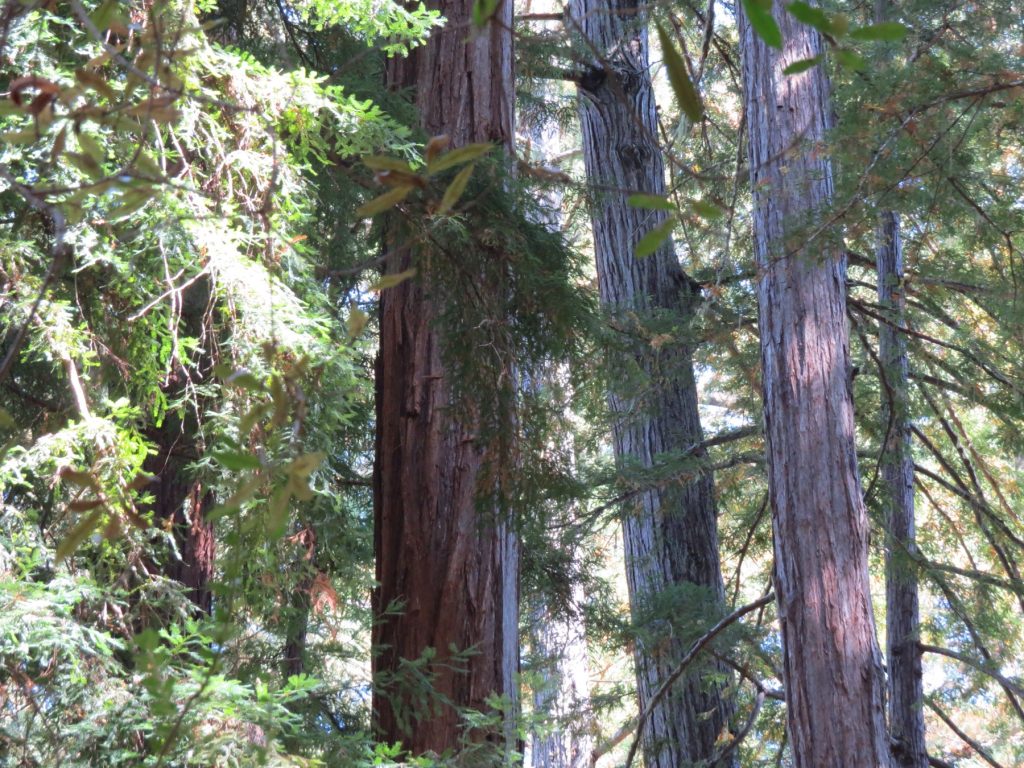
Redwood National Park has the feel of a soaring, gothic cathedral—only more so. One of the great Sequoia sempervirens trees may live for two millennia, but when it falls, new trees will grow from the fallen trunk. (Hence the scientific name, which means “ever-living sequoia” in Latin.) The redwoods are the tallest trees on Earth, commonly more than 200 feet (60 meters) and with the very tallest soaring above 379 feet (more than 115 meters). If such a tree growing on the goal line fell over, it would stretch the length of a football field and the top branches would extend into the stands at the end. Ferns growing in the duff beneath the redwoods are lost, inconsequential, despite occasionally standing shoulder-high or above. Reports from early loggers included trees even taller than any known today.
The redwoods lie in the southern part of the great, coastal, temperate rainforest that extends from San Francisco north along the Pacific coast to southeastern Alaska, and includes the Olympic National Park discussed earlier. The redwoods actually grow in soils that came from rocks much like those of the Olympic.
Redwoods are mostly restricted to a narrow band along the coast with 50-100 inches (1.25-2.5 meters) of rain per year, and with frequent to continuous fogs that slow the drying-out of the trees. The trees, in turn, help maintain the fog; cutting the trees may decrease the fog, making it difficult or impossible for the redwoods to re-grow. The wood of redwood trees is highly resistant to fire and rot, and so is greatly sought after. Logging of old-growth redwoods, thus, is a contentious issue; an estimated 96% of the old-growth forest has been cut already, and with typical ages of 500-700 years and maximum ages of about 2000 years, a new “old-growth” forest is not returning soon, but some people want to cut the remaining 4% or so of the original old-growth redwood forest. Fossil evidence shows that redwoods once were much more widespread. U.S. parks that preserve fossilized redwood include the Petrified Forest, Yellowstone, and the Florissant Fossil Beds.
A bit farther south and higher on the slopes of the Sierra, but still in a wet zone, are the great sequoias of Yosemite, Kings Canyon and Sequoia National Parks. These Sequoiadendron gigantea are close relatives of the redwoods. Although not as tall (“only” up to 311 feet, or about 95 meters), the great sequoias are more massive. The General Sherman tree, at 275 feet tall and 102.6 feet around, is generally considered to be the largest single-trunk tree on Earth (and much larger than whales and such). The great sequoias are extremely fire-resistant, and require fire to clear-out competing trees and trigger sprouting of sequoia seeds. Fire suppression instituted after the parks were established led to a period with few or no new sequoias sprouting; now, prescribed burns and procedures that allow some natural fires to burn are returning the forest to a more-natural state. Sequoias can live 3500 years.
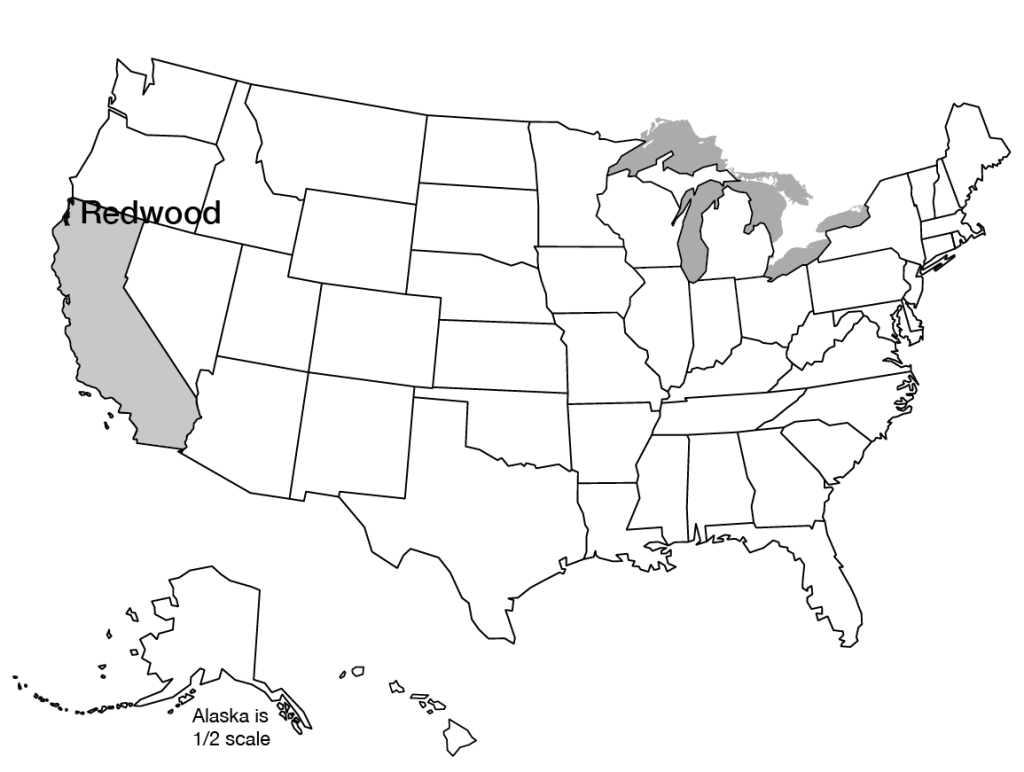
A few hundred miles to the east of the redwoods and sequoias lies the U.S. Great Basin. All across this region of Nevada and adjacent states, rainfall typically is less than 10 inches (25 cm) per year, with Death Valley receiving just 1.6 inches (4 cm) per year on average. Sage and cactus grow here instead of towering trees – in response to the very hot, dry conditions. Yet, above the clouds, this region receives the same amount of sunshine as do the redwoods. Clearly, the climate is much more than just the amount of sunshine above the clouds. We now take a brief tour through the basics of climatology. This should help you to understand climates, weathering, erosion, and glaciers, and a number of important near-surface processes.
Why the Wind Blows
The wind blows, and the deep mantle convects, for more-or-less the same reason. Both the air and the mantle are capable of flowing, and both are heated from below and cooled from above. The amount of heating and the rate of flow are VERY different, which helps make the world interesting. But you might see a thunderstorm and imagine hot-spot formation, and there is at least a little similarity between a cold front and a subduction zone.
Anyway, on Earth, the equator receives more sunshine than the poles. Some of the energy reaching the Earth is reflected back to space from clouds or snow and ice, especially near the poles. Much more sunshine is absorbed to heat the Earth at the equator than at the poles.
The equator receives more sunshine because of simple geometry. Imagine for a moment that Dr. Alley’s head is the Earth, with his nose on the equator and the bald spot on top the North Pole. (See the picture; you can congratulate yourself on good taste if you didn’t imagine a bad joke about the South Pole here.) If he stands in front of a sun-lamp “sun,” he’ll never get a sunburn on his North-Pole bald spot, but he will on his equatorial nose.
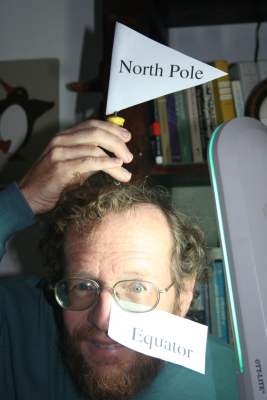
The Earth works the same way—at the top of the atmosphere, the amount of sunlight passing through a square meter is the same at the equator as at the pole (see the diagram below). But because of the Earth’s curvature, the light passing through a top-of-the-atmosphere square meter at the equator illuminates a square meter at the surface, whereas the light passing through a top-of-the-atmosphere square meter near the poles is spread over many square meters on the surface. (Additionally, in both cases, the rotation of the Earth spreads the light over a larger area than at the top of the atmosphere.)
This means that land at the equator becomes hotter than the poles. If we had no atmosphere or oceans, the equator would become too hot for life as we know it, and the poles too cold. However, the atmosphere and oceans take some of the excess heat from the equator to the poles, making both habitable to humans.
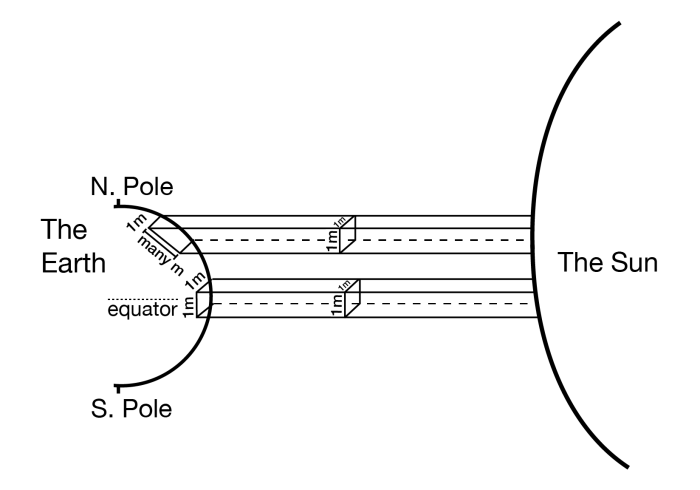
As the sun heats the land at the equator, the land heats the air above, and the air expands, rises, and then moves poleward in convection currents. Some of the energy in this hot air goes to warm the regions along the way, but eventually all the energy is radiated back to space. The sunlight that comes in is called shortwave radiation (because its waves are short—this stuff really isn’t that complex a lot of the time!), and the radiation going out has longer waves and is called longwave radiation. We will see later that the difference between shortwave and longwave is important in understanding the greenhouse effect. For now, note that the global energy budget is balanced—the total amount of energy brought in by short waves and absorbed in the Earth system is very nearly equal to the total amount of energy taken out by long waves to space. (At the moment, we are sending out a little bit less than we receive, and the Earth is warming, because we humans are changing the composition of the atmosphere. But, once we quit doing that, the Earth will get back to balance.) A factory balances the total amount of stuff coming in and going out, but little auto parts come in and big cars go out; the earth balances the total energy coming in and going out, but short waves come in and long waves go out. And, the uneven heating drives the wind, and the wind plus uneven heating of the oceans drive ocean currents.
Because the Earth rotates, the winds end up turning rather than going straight from equator to pole, and this makes the weather much more interesting than it would be on a non-rotating planet. If you want to explore this a little more, see the optional Enrichment.
Heating Death Valley
Some of our friends in meteorology just hate it when we say that warm air can hold more water than cool air. They like to say that the saturation water-vapor pressure in the atmosphere increases with temperature. But this means that warm air can hold more moisture than cool air.
Air is cooled in two major ways—by losing energy to its surroundings (longwave radiation to space, or warming the polar regions), or by being lifted. As air is lifted, it expands and cools. You can experience this by letting air out of a high-pressure bicycle tire, and feeling how cold the air becomes as it expands. Lifting may be caused when one air mass moves over another along a front, or when air moves over mountains. In either case, higher elevations have lower temperatures.
Cooling causes condensation of the water vapor in the air because cooler air can hold less water, and the condensation makes clouds and then rain or snow. Our friends in meteorology would point out that condensation requires cloud condensation nuclei—little dust particles and such that water drops can grow on—plus a little supercooling to get things started, or else extreme cooling if the nuclei are absent, but if you make a parcel of air sufficiently cold, clouds form and then rain or snow. (And if it bothers you that cooler temperatures exist higher, but that cold air sinks, see the optional Enrichment—there is really no problem, and it all does make sense.)
Evaporation of water requires energy. Remember that everything we see—including water—is made of fast-moving particles (atoms, or groups of atoms called molecules). The faster-moving particles are the hotter, higher-energy ones. In a pool of water (the ocean, or a drop of sweat on your brow) the faster, hotter water molecules break the attraction to their neighbors and escape, or evaporate, leaving the slower, cooler ones behind. Evaporation thus cools the remaining water. More heat then is conducted or radiated into the water from its surroundings (because heat flows from warmer to cooler places, and the evaporation has left the water drop cooler), cooling the surroundings while fueling more evaporation. This is why sweating cools a body. Condensation is the opposite of evaporation, and when condensation occurs, the heat that was added to the water to cause evaporation is released back to the air.
Now, consider a parcel of air rising up the Coast Ranges above the redwoods, and up the Sierra Nevada above the giant sequoias. As the air rises, the pressure on it (the weight of the air above) becomes smaller, and the air expands and cools. Once the air has cooled enough, it becomes saturated with water, and further cooling causes condensation. But the condensation releases some heat that partially counteracts the cooling from expansion. Air in which condensation is not occurring cools by about 1ºC for each 100 meters it is lifted, but air from which clouds and rain are forming only cools about 0.6º C for each 100 meters it is lifted (5ºF per 1000 feet dry, and 3ºF per 1000 feet wet). The difference represents the heat released by the condensation. The heat released by condensation originally came from the sun, and was stored in the air in the water vapor when water evaporated, cooling the ocean. As the vapor condenses, the sun’s energy is turned into heat that one can feel.
Strong moisture-laden breezes from the Pacific rise as they hit the redwood-clad Coast Ranges of California, cooling and raining to nourish the rainforest. The winds continue upward over the Sierra, cooling by 3ºF per 1000 feet upward, as they precipitate. By the time the wind has risen 15,000 feet to get over the high peaks, it has cooled about 45ºF (25ºC), and has rained or snowed almost all of its moisture. When this wind continues on down the other side, it is dry, and warms at the dry rate of 5ºF per 1000 feet. When this wind returns to sea level, the air has warmed about 75ºF (42ºC) on the way down. Hence, the wind comes down about 30ºF (17ºC) warmer than when it went up, and the difference is the heat that was stored when the rainwater evaporated from the ocean. A comfortable onshore breeze at 70ºF on the Pacific Coast will be 100ºF when it reaches the valleys on the other side. Add a little solar heating through the cloudless desert air, and it is no wonder that Death Valley is hot! (And yes, the wind usually goes around the Sierra rather than over, so you haven’t learned everything about meteorology in one short chapter of a geology book; but it’s a start.)
Weathering, Weather, and the Badlands
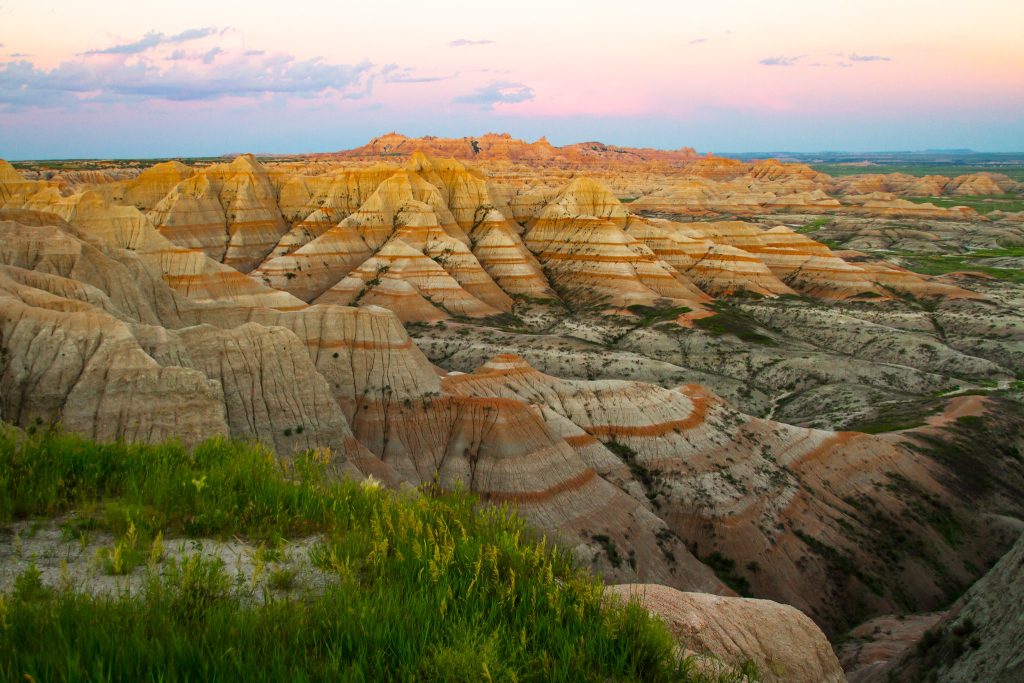
The Badlands of South Dakota are much more than just the land to the south of Wall Drug Store (“Have you dug Wall Drug?”). Today, the Badlands may be most valuable as a wonderful piece of the shortgrass prairie that once covered much of the western Great Plains. The sea of grass and flowers that nourished the bison and the native Americans of the plains has been almost entirely broken to the plow. But in the upper prairie of the Badlands, the grass still waves in the breeze like an ocean, the pronghorn still course the grass, and one can, perhaps, imagine what the prairie once was.
The Badlands are a creature of the Rockies. During one of the phases of uplift of the Rockies (especially about 30 million years ago), the exposed rocks were first weathered (changed into other forms, such as clay), and then transported from the mountains onto the plains to the east, or on down the Mississippi River system to its delta. Those sediments deposited on the Great Plains piled up until the mountains were almost completely buried, and an unbroken ramp of sediments extended to the Mississippi. The sediments were mostly river deposits, on flood plains or in channels of rivers, although some ash-falls from volcanoes and other wind-blown sediment were present.
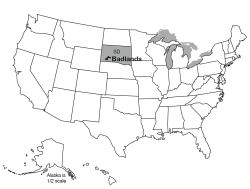
Eventually, renewed uplift of the Rockies rejuvenated the streams draining through the Badlands, causing these streams to cut down through the older deposits. In these deposits are uncounted fossils of the animals and plants that lived on those floodplains. The fossils tell a story of gradual drying from wetter times of the past, and of changes in the types of things living there.
The types of clays and volcanic ashes in the Badlands, combined with the climate in which they now occur, do not make fertile, stable soils. The clays expand and shrink on wetting and drying, breaking roots, triggering small landslides, and helping keep the slopes unvegetated. Water doesn’t flow easily through clay, so rainfall doesn’t soak in but flows rapidly across the surface during the rare but intense rainstorms, eroding channels in the clays and washing away vegetation; this also leaves the soils dry between rainfalls so that plants have difficulty sustaining themselves.
That a lush prairie can grow on the flatter regions is testament indeed to the hardiness of the prairie ecosystem. But, on steep slopes, the pastel-colored muds eroded from the old Rockies are exposed, along with the fossils they contain. We will explore stories of this sort over the next few weeks. We start with weathering, the changes that can turn hard rocks to soft clays of the type observed in the Badlands.
Weathering Processes
Squeezing mud, perhaps with a little heating, produces a sedimentary rock called mudstone or shale, and with further heating and squeezing this rock changes to various other things on the way to melting (you may have met shale→slate→schist→gneiss somewhere; we saw gneiss in Rocky Mountain, and all of them in the Enrichment, last time). The materials in mud are stable (or at least nearly so) under Earth-surface conditions but not deep in the Earth. And minerals produced deep in the Earth usually are not stable under surface conditions. Compared to deep in the Earth, the surface is wetter, has more oxygen, has a wider range of acid/alkaline conditions (with acid especially common at the surface), and has many more organisms trying to break down the minerals to extract fertilizer.
As a general rule, the further surface conditions are from conditions under which a mineral formed, the more rapidly that mineral changes at the surface. (This “rule” has many exceptions, but it is often useful, especially with silicate minerals.) The changes that occur at a place are called weathering. Moving the products of weathering is called transport. Weathering and transport together make erosion.
Weathering in turn is divided into mechanical and chemical weathering. Mechanical weathering is the making of little pieces from big pieces; chemical weathering is the making of new types of materials that were not there previously.
Mechanical Weathering
To turn big pieces into little ones, the big ones need to be cracked. Cracks in rocks are caused or enlarged by processes including:
- Mountain-building stresses, or earthquake-release stresses, breaking the rocks;
- Expansion and breakage of rock as the weight of overlying rock is removed during erosion of that overlying rock;
- Expansion and contraction during heating and cooling (especially very near the surface during forest fires);
- Growth of things in cracks (tree roots, minerals).
Probably the most important mineral that grows in cracks is ice, but others do too. For example, the mineral thenardite, Na2SO4 (no, you don’t have to memorize the formula!) can add much water to its structure (10 molecules for each Na2SO4), expanding in the process. If thenardite exists in an environment that alternately is wetted and dried, the resulting expansion and contraction from adding and losing water may break the rocks around it. Increased humidity will cause the mineral to rearrange and take up water, expanding and wedging open cracks. Continued wetting may dissolve the mineral, which will move deeper in the crack in the rock and then be redeposited and dehydrated during a subsequent dry time. Then further wetting will cause re-expansion and more wedging. This process is breaking many of the ancient monuments of Egypt as increased irrigation and other activities increase humidity in some places.
Chemical Weathering
Chemical changes are often more interesting and more complex than physical ones. There is a great range of possible changes, and you must know a lot of chemistry to really appreciate all of them. In general, the main agents of weathering are weak acids. Rainwater picks up carbon dioxide from the air and becomes a weak acid called carbonic acid. In soils, water may pick up more carbon dioxide plus organic acids from decaying organic material, becoming a stronger acid.
When acid attacks a rock, the results depend on what minerals are present, and how warm and wet and acidic conditions are, among other things. We can sketch some general patterns. Suppose we start with granite, a silica-rich rock that forms in a few continental and island-arc settings, including when bodies of melted rock solidify beneath the andesitic volcanoes of subduction zones.
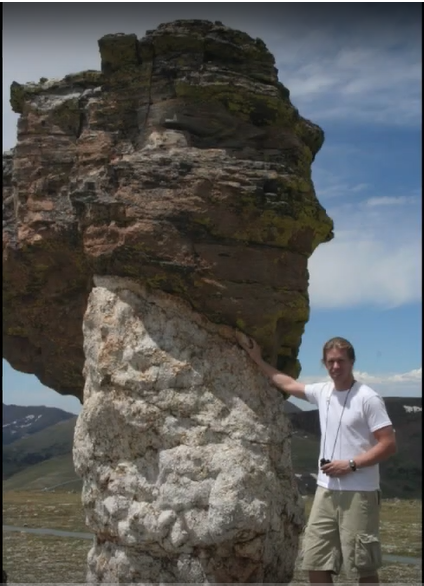
Granite usually is composed of four minerals: quartz (pure silica, which is silicon and oxygen), potassium feldspar and sodium-calcium feldspar (mostly silica, with a little aluminum replacing some of the silicon, and the potassium, sodium or calcium added for balance), and a dark silica-bearing mineral containing iron and magnesium (often a dark mica called biotite). Interestingly, almost 99% of the atoms in the rocks of the crust of the Earth are oxygen, silicon, aluminun, iron, calcium, sodium, potassium or magnesium, the common elements in granite. We discuss granite here because it does so well representing the whole crust.
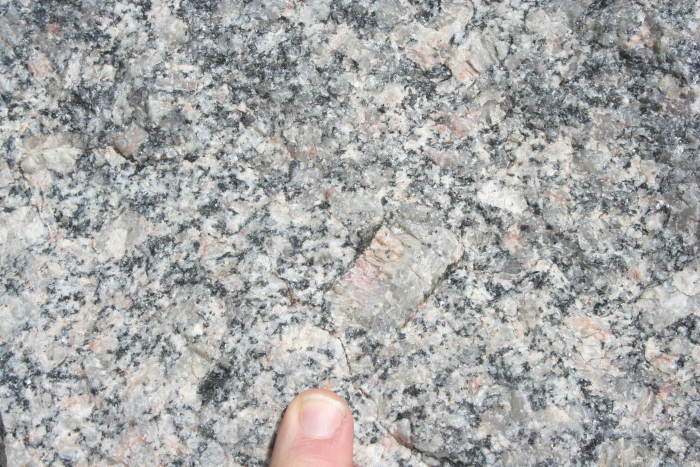
When granite interacts with carbonic acid, several things happen.
- Iron (Fe) rusts. It picks up water and oxygen, and remains in the soil as little pieces of rust.
- The aluminum (Al), potassium (K) and silica (SiO2) from the feldspars and from the dark mineral rearrange into new minerals, called clays, that also include some water.
- The calcium (Ca), sodium (Na) and magnesium (Mg) dissolve in water and wash away.
- Most of the quartz (silica as a mineral) sits there almost unchanged as quartz sand (a little of it may dissolve and wash away, but most stays).
One can write a sort of equation:
Granite → quartz sand + clay + rust + (dissolved-and-washed-away Ca + Na + Mg).
The calcium and silica dissolved and washed to the ocean are used by sea creatures to make shells, the dissolved magnesium washed to the ocean usually ends up reacting with hot rocks at spreading centers to make new minerals in the sea floor, and the dissolved sodium accumulates in the ocean to make it salty. (Eventually, evaporation of ocean water in restricted basins causes deposition of salts including table salt, which is sodium chloride, written NaCl. Also, some salt is taken down subduction zones with the water in the spaces in sediment. So, the ocean does lose sodium as well as gaining sodium.) The rust, sand, and clay left behind, plus a little organic material often including worm poop, become the indispensable layer we know as soil.
You should recognize that this is a very general description of what happens; were it this easy, there would not be hundreds of soil scientists working to understand this important layer in which most of our food grows. In general, the hotter and wetter the climate, the more stuff is removed—rust and quartz sand can be dissolved in some tropical soils, leaving aluminum compounds that we mine for use in making aluminum. In dryland soils, the Ca and Mg may be left behind (forming special desert soils), or even the Na may be left behind, forming salty soils in which little or nothing will grow.
You also should recognize that the “chunks” in soil – rust, clay, sand and organic materials – can be carried away by streams or wind, but as chunks rather than invisible dissolved materials. We discuss this loss of chunks in the next sections. If chunks are carried away more rapidly than new ones are formed, the soil will thin and we will find it difficult to grow food to feed ourselves.
When we were looking at subduction zones, we noted that old, cold sea floor goes down. We now see that it takes some extra magnesium, added from sea water by reactions with the hot rocks at the mid-ocean ridges. Sediment goes down subduction zones, including the calcium- and silica-bearing shells of sea creatures, the rust and clay washed from the continents, and some sea water. When these melt and feed volcanoes, andesite and similar rocks are made during eruptions, or their underground equivalents including granites are produced. The calcium-bearing shells include carbon dioxide, and this plus water escape from the volcanoes to make carbonic acid to attack the new granite. The Earth really does cycle, and recycle, everything! But, going around this loop once takes at least millions of years, and may take a lot longer than that, issues we’ll discuss later.
Another Reason Why Loose Rock Matters: Mass Movement and the Grand Tetons
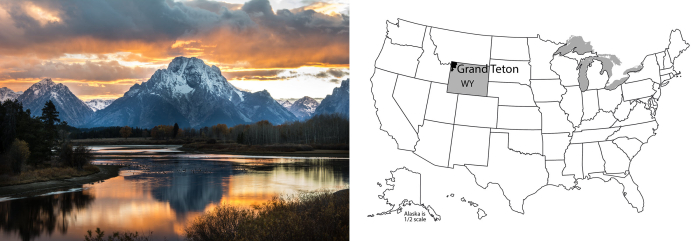
The Grand Tetons tower above Jackson Hole, Wyoming, the epitome of western scenery for many people. A steep pull-apart fault lies along the front of the range and slopes downward beneath Jackson Hole. From the highest peaks to the Hole is well over a mile (roughly 2 km), but the total offset on the fault (including material eroded from the top of the range and deposited in the valley) is almost 6 miles (10 km). The uplifted block is primarily old metamorphic rocks that erode only slowly. The faulting is probably related to the Basin and Range extension that also gave us Death Valley, although the complexity of the region makes any interpretation difficult. Dr. Alley recalls huddling next to an overhanging rock, far up on the steep front of the Tetons, watching hailstones rattle off the trail from a black deck of clouds barely over his head. It is a truly awesome place.
A few miles (few km) east of the park is another interesting feature: the Gros Ventre slide. There, the rock layers slope steeply under a long ridge or mountain, with the layers almost parallel to the mountainside, down to the Gros Ventre River. Strong, resistant sandstone rests on weak, slippery shale. The river has eroded down through the sandstone and into the shale, leaving the toe of the sandstone unsupported. In June of 1925, after a particularly wet spring, the entire mountainside let loose, sliding down and across the river. The slide mass made a dam, trapping a lake miles long and 200 feet (60 m) deep. The entire slide probably required only seconds to occur, and moved cubic miles (many cubic kilometers) of rock.
Such a debris dam is not very strong; water flow through its pore spaces or over it can remove rocks and weaken it greatly, until it collapses catastrophically. When we were discussing earthquakes, we saw that a similar slide happened during an earthquake in 1959 just northwest of Yellowstone, damming a river to form a new lake, and that the Army Corps of Engineers had rushed in to prevent collapse of the dam. The Corps had learned from previous experience, including events at Gros Ventre. In 1925, efforts were not made to stabilize the dam there. It collapsed two years later, washing out a small town downriver and killing six people.
Moving Masses
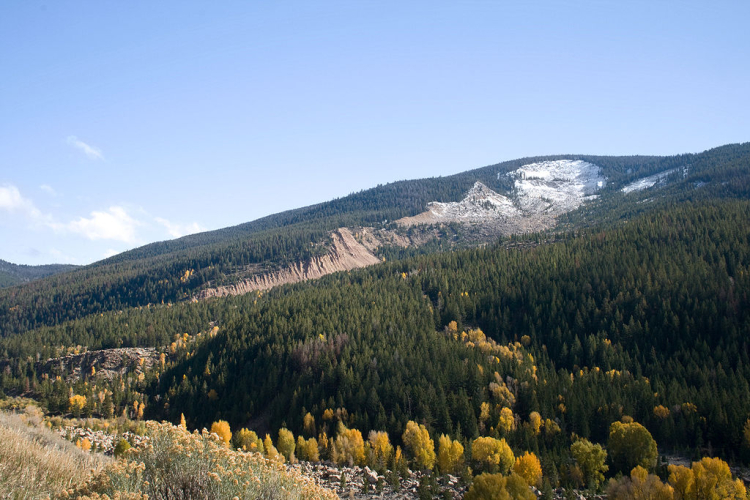
The Gros Ventre slide is an especially dramatic example of an important but usually-more-boring process: mass movement. This is the name give to the downhill motion of rock, soil, debris, or other material, provided the flow is not primarily water (if material is washed along by a river, we call it a river), or a glacier or wind.
Water is usually involved in mass movement, however, because most mass movements occur when soil or rock is especially wet. This happens for four reasons: water makes the soil heavy; water lubricates motion of rocks past each other; water partially floats rocks (a rock pushes down less in water than in air) so they are not as tightly interlocked and can move more easily past each other, and saturation of a rock mass removes the effect of water tension.
This last deserves a bit more explanation. Think about going to the beach and building sand castles. Dry sand makes a little pile with sides rising at maybe 30 degrees. Totally saturated (wet) sand flows easily, forming a pile with a much more gradual side. But damp sand can hold up a vertical face. You can even make and throw damp sand balls (be careful where you throw them).
Transcript:
Sand Castles
Credit: Dr. Richard B. Alley
So what’s going on with this dry damp wet sand, really what’s going on down in it. Well let’s take a zoom in on the dry sand. These are individual grains of sand made bigger and they make a nice pile that is sort of like this one. You could have a pile like that underwater and totally wet, but the water supports some of the weight of the grains of sand. The water makes it easier for the sand grains to move over each other and so even a little shake or a little current tends to knock down the pile and give you something very broad and not at all steep on the edges such as what we show here. In between the damp case, water molecules tend to stick to other water molecules and they tend to stick to the sand. So when the water is sticking to the sand and the other water, it sort of forms like you see in this diagram. And if we zoom in, here’s two grains with the water in between sticking to the sand grains and to the other water molecules. If you were trying to pull the sand grains apart, it takes a force because you either have to pull a sand grain or both sand grains out of the water and break that attraction or you have to pull the water apart and break that attraction. And so the strength of the water sticking to the sand can hold up a sand castle or it can hold up most of the hillside slopes on the earth, most of the time. So here are three dr,y which might give you a sand dune, and damp, which can give you really spectacular sand castles and holds up most of the slopes on Earth, most of the time. But when you make them really wet they may make landslides and run down the hill and that’s not good if you’re in the way.
The details of the surface physics involved are a bit complicated, but basically, a drop of water will sit at the junction of two sand grains. Pull the sand grains apart, and some water will end up on each grain. This requires “breaking” the water; what had been one continuous film of water is now broken into two. Next, think of a dripping faucet. A water drop doesn’t fall off immediately, but first becomes large and heavy. Clearly, water has strength, and does not “like” to be broken. (This strength arises from the attraction of water molecules for each other, and is usually called surface tension.) Damp sand thus is strong—a landslide would require some sand to move rapidly past other sand, breaking the water bonds between the grains. In fully wet sand, however, the grains move about in the water without ever breaking it, so motion is easy.
There are elaborate classifications of mass movements, depending on how fast, how wet, how coarse, how steep, and how “other” they are. Most of the names make sense: falls are rocks that fell off cliffs, topples are rocks that toppled over from cliffs, landslides and debris flows and debris avalanches are fast-moving events, and slumps are failures of blocks of soil along concave-up curved surfaces, something like a person slumping down in a chair.
One fascinating, and scary, type of mass movement occurs on “quick” clays. These are clays usually deposited beneath the sea, in which the playing-card-shaped clay particles exist in a house-of-cards structure stuck together by ions of the sea’s salt, which sit in the spaces between clay particles. When raised above sea level, ordinary water begins to replace the ions of the salt, and the structure becomes weaker. Eventually, it may fail catastrophically, going from a solid to a very thin liquid almost instantaneously, and generating a flow. Flows from such clays are known especially from parts of Canada and Scandinavia. Such a flow crossing a road can pose a problem, because bulldozing the clay out of the way does little good; more just flows across. But throwing a bag of salt into the flow near the road and driving a tracked vehicle through to mix the salt and clay may cause the flow to solidify so that it can be bulldozed away. Tragically, large portions of some towns have been destroyed, with much loss of life and property, when such quick clays have failed under buildings. Fortunately, these are quite rare.
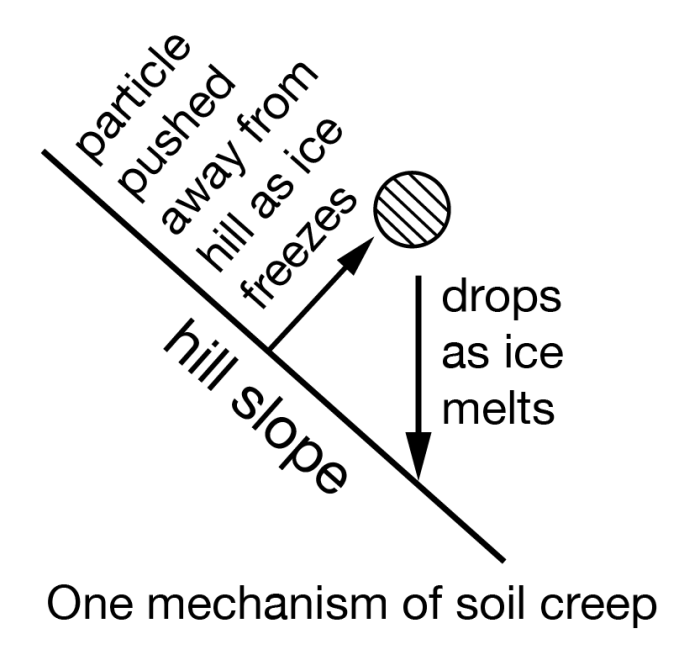
The most important mass-movement type in terms of transferring material downhill is soil creep, the slow (typically inches, or centimeters, per year or less) downslope motion of soil. Creep may be a very slow landslide. It may occur from freeze-thaw processes—a column of ice that grows under a small pebble on a cold night pushes that pebble out from the hillslope, and the pebble falls straight down when the ice melts, effectively moving a tiny distance down the hill (see the figure above). When trees fall over and uproot soil, or when groundhogs and even worms dig out rock grains and allow them to move downhill, creep is occurring. If you look at a typical hillslope, streams on the lower slopes are present to move water and rock downhill, but the upper slopes lack streams. There, soil creep serves to move material downhill.
Hillslopes typically reach a balance, in which weathering breaks down rocks about as rapidly as mass movement and streams take the broken rocks away. The balance may occur with bare rock sticking out (as in some cliffs, for example), or with a lot of soil covering the rock. If soil creep dominates the mass movement, the hillslope may always be close to balance. If landslides dominate, then the soil will build up for a long while before suddenly slumping off, and you have to watch for a long time to see that formation and transport of soil are in balance. And, over very long times, the hill will eventually flatten, causing the mass movement to slow. However, soil will very gradually thicken to slow the weathering as the hillslope is reduced, and near-balance will be maintained.
Humans are greatly upsetting this balance worldwide. Our activities—bulldozing, cutting trees whose roots held the soil, plowing, and more—are moving more material than nature moved before we were involved.
GeoMations
Redwoods:
Transcript: So out here there’s the great Pacific Ocean. And the wind comes trucking in from the Pacific Ocean. And it’s just going great guns except at some point it runs into the giant mountain range of the Sierra, which we know goes up over the top and down the other side and down to Death Valley.
And so when the air runs into that, the air has to rise. And you may know that when air has to rise, it expands. And when you have air expanding, whether it be out here on the Pacific or from a bicycle tire, it cools. And when the air cools that makes nice clouds. And when that makes clouds that makes rain that comes dripping down. And so sitting underneath that, as you might imagine, you have really wonderful trees called the Redwoods because it rains like crazy on them. And they’re really happy with that.
Now the air is cooling and the cooling rate is something vaguely about three degrees Fahrenheit for each 1,000 feet that the air goes up. It should be five, five is the thermodynamics. But when the cooling causes condensation that makes the rain that we see, condensing actually gives up a little heat. And so you only get a cooling of about three degrees Fahrenheit per 1,000 feet going up.
Now when the air comes over the top and starts coming down the other side, there’s no water in it to evaporate. There’s no water there, it’s dry. And when air is coming down like that and being squeezed, it ends up warming. And that warming is about five degrees Fahrenheit per 1,000 feet that it comes down.
And so it cools going up at about three degrees Fahrenheit per 1,000 feet. It warms coming down five degrees Fahrenheit per 1,000 feet. And that in turn means that because the mountains are really high, that if the air comes trucking in at something like 70 degrees Fahrenheit, by the time it goes over 15,000 foot high, it’s almost 15,000 feet to the top of the Sierra, and the air has to get over, why when it comes back down here to Death Valley, it is 100 degrees Fahrenheit. And you really would be wiser to go visit in the winter rather than in the summer.
Why the Wind Spins
The rotation of the Earth is surprisingly fast. If you buckled a belt around the Earth at the equator, the belt would need to be 25,000 miles (about 40,000 km) long. The Earth spins once every 24 hours. This means that the Earth’s rotation is moving a point on the equator just over 1000 miles per hour (1600 km/hr). In comparison, a point near the pole is essentially stationary (the pole itself stays in place as it rotates). Dr. Alley has walked around the South Pole in three steps, but he couldn’t walk around the equator in a day. If this doesn’t make sense, get a tennis ball or the head of a friendly classmate, draw an equator, and try it out!
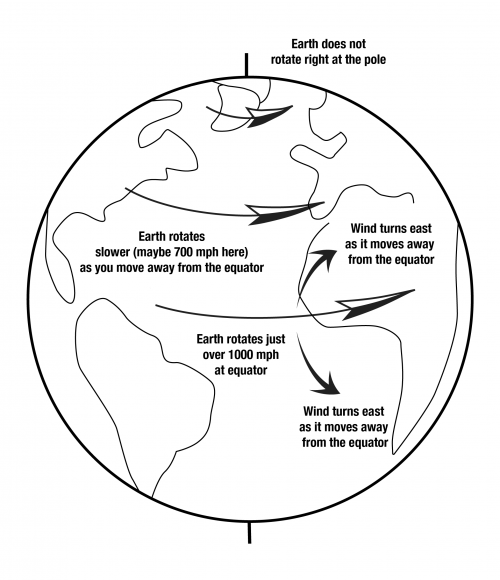
If you stand on the equator, the wind is not blowing 1000 miles per hour. This is fortunate indeed, because the “mere” 150-mile-per-hour winds occasionally reached in hurricanes can cause immense disasters. Rather, the air near the surface of the Earth on average is moving with the surface, because of the drag of mountains and trees and such on the air. This is somewhat akin to driving down the highway at 65 miles per hour with a bug stuck to your windshield. The wind at 65 miles per hour is plenty strong enough to blow a bug, but the wind very close to the windshield is very much slower than 65 miles per hour—really strong winds don’t blow close to surfaces, because of the friction of the surface, and instead the air close to the surface does almost the same thing that the surface is doing.
Now, suppose that you watch a parcel of air that rises at the equator and begins moving towards the North Pole in a convection cell. Once the air has moved a ways north, the Earth under it is no longer rotating at 1000 miles per hour, but is somewhat slower, perhaps 900 miles per hour and dropping northward toward zero at the pole. But aloft, there aren’t trees and mountains to slow the air down from the 1000 miles per hour it had at the equator. Thus, this air “gets ahead” of the Earth. The Earth rotates to the east—you see the sun rise in the east as the rotation of the Earth brings the sun into view—so, the equatorial surface air is moving east at 1000 miles per hour. As this air moves northward over slower-moving land, the wind will appear to turn to the right or east as it blows, getting ahead of the ground. Wind heading south from the equator will also move east ahead of the surface, making a left turn.
Similarly, wind moving from the pole to the equator in the returning limb of a convection cell will lag behind the rotating surface of the Earth, again seeming to turn to the right in the northern hemisphere (and to the left in the southern hemisphere). Thus, the wind cannot go directly to where it “wants” to go; instead, it turns and tends to go in circles. The circular air flow around low-pressure systems and hurricanes is unavoidable on a rotating Earth.
More-precise definitions are possible of this “Coriolis effect,” the turning of flows on a rotating Earth. The intuitive explanation given above will fail you if you think of a wind moving due-east or due-west, because those also turn. Starting from conservation of angular momentum might be better, and you can find that in any good meteorology textbook. Notice, however, that the explanation given above will get the right answer for you, in how much the wind will turn, and which way.
Notice also that Coriolis turning affects large, fast flows. The convection in the Earth is too slow to feel Coriolis much. The difference in rotation speed between opposite sides of a sink or toilet is so tiny that Coriolis turning has no significant effect on the direction that water swirls as it goes down. That is controlled by the design of the sink or toilet, and by any motion in the water at the time the drain is opened; get the water swirling in a sink and then pull the plug, and the water usually will keep swirling in the way you started it as it goes down. Dr. Alley has seen both clockwise and counterclockwise flows in Pennsylvania and Greenland, and in New Zealand and Antarctica.
More Enrichment: Why Cold Air Sinks but Valleys Are Warmer than Mountain Peaks
When air moves up, it expands, which requires that work is done in pushing away other air to make room for the expansion. The work requires energy, which comes from the heat energy in the air, so the rising air cools. Similarly, when air moves down, it contracts as the surrounding, higher-pressure air squeezes the sinking air parcel, and this squeezing is work that is done on the sinking parcel, and warms the parcel. If this is happening near the surface of the Earth, and the air is dry, the change in temperature is about 1oC per 100 m of vertical motion. This applies everywhere, at all times. So, in the 2004 movie, The Day After Tomorrow, when huge storms brought air down from above so rapidly that the air didn’t have time to warm up, that was complete hooey.
Now, imagine that a “chunk” or parcel of air, sitting somewhere, cools a little (say, by radiating energy to space as the sun goes down in the evening), and you want to know whether that air parcel will sink now. If your air parcel sinks, it must warm by about 1oC per 100 m of sinking, and it must push other air out of the way. You measure the temperature of your parcel, add 1oC for the warming from sinking 100 m, and if your air is still colder than the air it must displace 100 m below, then your parcel will sink. (Friction comes in as well—if your parcel plus 1oC would be only a tiny bit colder than the air it must displace, motion is unlikely; you need a notable difference.)
Overall, a balanced, stationary atmosphere will cool upward by about 1oC per 100 m under dry conditions, and slightly less under wet conditions (when cooling causes condensation that releases heat which offsets some of the cooling, or warming causes evaporation that uses heat which offsets some of the warming). Vertical motions will be triggered when cooling or warming creates air that is anomalously cold or warm relative to this stationary profile. So, cold air on a mountaintop won’t necessarily sink, unless that mountaintop air is anomalously cold. Perhaps on an October evening in the Appalachians, when a fog develops and holds heat in the valleys while the mountaintop radiates heat to space, then the mountaintop air will become anomalously cold and sink to the valleys.
Key Takeaways from Weathering and Mass Wasting
Weather, Weathering, and Landslides
- Sun hits equator straight-on, poles a glancing blow, so equator gets more sun.
- Sun heats Earth, drives convection in the atmosphere.
- On rotating Earth, this creates interesting winds including onshore breezes on US West Coast.
- Winds rise up Coast Ranges and the Sierra Nevada, watering redwoods and sequoias.
- Winds sink down into Death Valley, drying it.
Why Redwood Wet, Death Valley Dry?
- Warmer air can hold more moisture.
- Rising air expands and cools, sinking air is compressed and warms.
- Air from Pacific is wet, rises over Redwood and rains, dry air comes down the other side into Death Valley.
- Air cools 3oF for 1000 foot rise going up, warms 5oF for 1000 foot fall coming down; for 15,000-foot-high mountains, air comes down 30oF warmer than it went up.
Rocks Not Forever
- Mechanical Weathering=physical changes that make small rock pieces from big pieces.
- Chemical Weathering makes new minerals.
Mass Movement
- Mass movement is the downhill transport of soil, rock without rivers.
- Mass movement ranges from huge, destructive landslides to barely measurable soil creep.
- Rivers usually pick up material from mass movement and take it away.
- Usually get a balance between soil production by weathering and soil removal, although humans are upsetting the balance in many places.
- Can often figure out where mass movement is potentially destructive, and stabilize slopes or stay out of the way.

